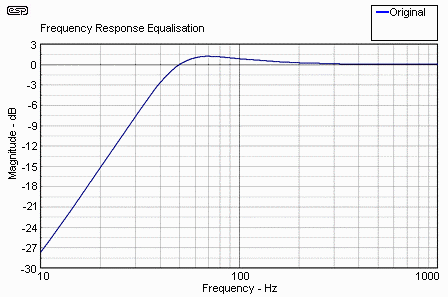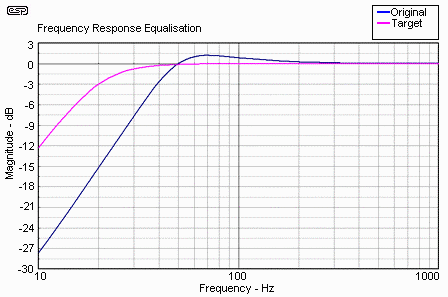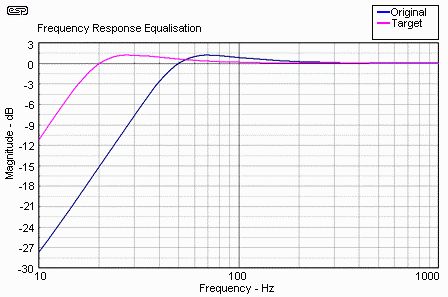
 |
The Audio Pages |
| Elliott Sound Products | Linkwitz Transform Circuit |
Copyright ![]() 2001 - Jeremy Wolf
2001 - Jeremy Wolf
(Edited by Rod Elliott -
ESP)
Updated 20 Jan 2002 *
From the editor ...
Jeremy Wolf wrote this article with some considerable consultation
from Siegfried Linkwitz and a small amount from me. Since the Linkwitz
transform circuit seems so mysterious (which it is), it is assumed by many
readers
of The Audio Pages (and others) that it must be complex. The mathematics
certainly are, but the principle is not, as Jeremy explains.
There are caveats (of course) and compromises (which are a base requirement in every speaker ever made), but this article explains the overall benefit. I know the benefits well - a sealed equalised subwoofer will simply wipe the floor with anything else, provided that you have done your homework. Now, you don't even have to do that, since Jeremy has done it for you.
| Q.. | What is a Linkwitz Transform? |
| A | The Linkwitz transform was developed by Siegfried Linkwitz. It allows you to take a driver in a sealed enclosure that has an Fc and Qtc for that box and lets you “transform” or simulate a new Fc and Qtc for that driver in that box. |
| Q | How does it work? |
| A | Magic |
| Q | No seriously, how does it work? |
| A | It works by creating a precise equalisation curve to compensate for any peaking or rolling off that the driver is encountering. By doing this, a new Fc and Qtc can be assigned to that system. |
Actually it is a simulation because you cannot physically change the Fc and Qtc of a closed system without actually making the box bigger or smaller or putting stuffing in the box and making it appear bigger. The following is an example of the above explanation with graphs to help clarify what is being said.
Ok, let's assume that you have a driver with the following specifications.
Fs = 33.5 HzNow we are going to put this driver in a 38 litre (1.378 ft3) box. This will net us a Qtc of 1.0 This speaker in this box will yield the following results (these data can all be obtained from the Linkwitz Transform spreadsheet on the downloads page, courtesy of True Audio) ..
Qts = 0.75
Vas = 46.1 litres (1.647 ft3)
Fc = 49.6 Hz
F3 = 39.0 Hz
Qtc = 1.000
Vb = 38 litres

If you notice in this graph, there is a 1.2 dB hump before the roll off occurs. While this response is ok for your average listener, we are not satisfied with it and want to change the response. Wouldn’t it be nice if we could simply move the Fc down to say 20 Hz and have the Qtc = 0.707 to get a response that looked more like this ...
Fc = 20.0 Hz
F3 = 20.0 Hz
Qtc = 0.707

As you can see, the magenta line is the newly transformed response. It is much more suited for low frequency reproduction after being transformed. There will now be a much greater output in the lower octaves.
And to show that the Fc is actually down at 20 Hz, here is a response of the same driver in that same box with after being transformed to a Qtc of 1.00 and Fc of 20 Hz. The slight peak causes the response to be 0 dB at 20 Hz, and this response is easily created by the Linkwitz transform spreadsheet if desired.
Fc = 20.0 Hz
F3 = 20.0 Hz
Qtc = 1.000

Getting back to our desired response of Qtc .707 and Fc of 20 Hz. The graph in Figure 4 shows the compensation that the Linkwitz transform is using in order to flatten out the response curve of our driver.

Figure 4 - Equalisation
Applied by Linkwitz Transform Circuit
The blue line represents the original driver with a Qtc of 1.0 and an Fc 49.6 Hz, F3 of 39 Hz. The red line represents the equalisation curve that the Linkwitz transform is supplying to the amplifier in order to compensate for the new Qtc and Fc. The transform is cutting out 1.2 dB in order to compensate for the Qtc of 1.0, which is causing a 1.2 dB, boost around 70 Hz. It is then providing boost at the lower frequencies at a rate that is equal to the natural roll off of a sealed enclosure. Instead of rolling off at 12 dB an octave, the speaker is being forced to maintain a flatter response due to the amplifier giving it a lot more power at the lower frequencies. For example at 20 Hz, the amplifier is giving the speaker an additional 12 dB of gain, or 16 times more power than at frequencies above 50 Hz.
Getting this kind of response out of a sealed enclosure setup requires some tradeoffs. You will be giving up some of the overall SPL producing capability of the driver because of the excursion overhead needed at the lower frequencies.
If your speaker is flat down to 50 Hz and you want to extend one octave below that to 25 Hz then you will lose 12 dB of overall output capability when producing sound at 25 Hz because you are using up all of the driver's excursion and most likely power handling capability too.
We'll say that we have an imaginary speaker that has these basic parameters
...
| Efficiency | 88 dB/m/W | |
| Xmax | 4 mm | |
| Max Power | 250W |
Below the Fc of 50 Hz the speaker will roll off at 12 dB / octave. That means at 25 Hz, the output of the speaker will only be 100 dB. To obtain the same 112dB output as before, you will need 4 times the excursion and 16 times the power (i.e.4,000 Watts!) as at 50Hz. This is because for every octave lower that you want the speaker to produce you need 4 times the excursion, and in order to obtain the excursion in an equalised system, you must have 16 times the power. To put this another way, excursion is equal to the inverse square of frequency. Half the frequency, four times the excursion, one quarter the frequency, eight times the excursion (etc.). The power requirement is the square of the excursion.
So, now that our speaker does not roll of at 12 dB / octave (because of the equaliser) and maintains a flat response to 25 Hz, it will need to use 4 times more excursion and 16 times the power to produce 25 Hz at 112 dB.
Now comes that tradeoff part that I was talking about before. The driver is using all of its power rating and 1 mm of its 4 mm of Xmax to produce 112dB at 50Hz. Now we want to achieve a flat response down to 25Hz by using the Linkwitz transform. That means we will be trading off some of our 112 dB SPL to gain some low frequency flat response. The speaker will be using 4 times the 1 mm Xmax or 4 mm of excursion to produce this 25 Hz frequency. The power needed is well in excess of the speaker ratings, so must be limited to 250W.
If we want to use this speaker in the transform, we now need to trade off 12 dB total maximum output for a total maximum output of 100 dB that is flat from 25 Hz up. That’s not too bad of a trade in my opinion. But remember, this is only an imaginary driver that I made up, not a real world example, although in reality, most "real" speaker drivers will not be all that far off. Every 3 dB increase in SPL requires double the previous amount of power. And in our case we needed 12 dB of gain which is 16x more power.
The two things to remember from this example are ...
Power compression is another aspect that should be considered. This occurs whan any loudspeaker is driven with a significant amount of power. The voice coil heats up, and the available power is reduced accordingly. Depending on the program material, you may easily lose 6 dB of SPL because of power compression (assuming that the system is being pushed to its limits). Power compression cannot be compensated for by using more power, as it is dynamic in nature. The effects are (perhaps surprisingly) not as noticable as one might expect, since sustained high power at extremely low frequencies is rare in virtually all normal program material.
Fortunately, this is not as big a problem as may be imagined, since typical low frequency energy levels are actually surprisingly low most of the time. Home theatre systems will be called upon to reproduce large amounts of relatively deep bass, but only for short periods at a time.
With most music, there is very little energy below 40 Hz, so power and excursion are not normally a problem. Pipe organ music is an exception - the 64' pipe on a full pipe organ is 16 Hz, but it is not used a great deal - in some cases because of the structural damage it does to the building housing the organ! If you are an aficionado of such music, I suggest that you use the largest box you can, with a very large driver. It may be wise to reinforce your home while you are at it (and no, I'm not joking).
With the explanation and examples out of the way, you might be wondering what kind of specs to look for when choosing a driver. Here are some guidelines that should help you.
1. There is a strong case for applying a highpass filter at between 5 and 15 Hz. This prevents excessive excursions at sub-audible frequencies, and offers a measure of driver protection. Ideally, this filter would have a steep slope (12 dB / octave minimum), but a simple 6 dB (first order) filter can still be used. The filter may be before or after the Linkwitz transform circuit, having the same effect regardless of physical position.
Use of any filter will have an effect on the actual response of the completed system, however this is generally small, causing perhaps a 2 dB error at 20 Hz. It is probable that virtually any room will create errors many times this figure, so it can generally be discounted.
2. There is a recommendation in the spreadsheet (see downloads page) that great care is needed with a maximum boost over 20 dB. I think that this is understatement, and care is needed with any boost above about 10 dB. The increase in power and cone excursion becomes extreme, although with most music, the actual energy level of signals below 40 Hz is relatively low.
There are some exceptions to this, and it should never be assumed that you won't need the power or excursion - someone will eventually prove you wrong.
3. You must remember that the box is sealed. The pressure exerted by a 380 mm (15") cone with an Xmax of 10 mm will literally split the seams of a box that is not sturdy enough (it apparently happens quite regularly with a certain well known subwoofer using a similar principle). The box must be as strong as you can make it - screwed, glued, and substantial internal cleats at all joins are essential. There is no such thing as a box that is too strong, but make sure that you account for the volume occupied by the strength members when you do the calculations). Bracing is usually not needed, since the frequencies are so low that panel resonance is unlikely if the unit is a self contained subwoofer. All panels should be of 18 mm (minimum) sturdy ply or medium density fibreboard (MDF) - do not use chipboard, the box will not hold together!
4. The use of a small (say 5 mm) vent stoppered with felt to present a significant resistance to airflow is also a good idea - especially if the woofer does not use a vented polepiece (via the dustcap). This allows air pressure to equalise slowly, since you will have to expend considerable effort to make sure that the box has no air leaks. If present, they will whistle or make some other equally undesirable noise when the subwoofer is in use. It is unlikely that you will be able to blame the dog for these noises (in case you thought you might get away with that excuse :-)
5. The Linkwitz transform circuit is available as a PCB with full construction details. The board incorporates a 15 Hz filter (this can be changed) and uses one dual opamp. To have a look, see Project 71.
6. My thanks to Jeremy for putting this article together. His efforts have saved me an enormous amount of time, and the article is written directly for the beginner or relatively non-technical reader. As many of you may have noticed, this is something I often have trouble with :-)
Rod Elliott
A special thanks goes to Siegfried Linkwitz for verifying this document and helping me explain in simpler terms what his circuit is doing.
Jeremy sent me an e-mail from a reader, who pointed out a couple of errors in the calculations for excursion and power. I have amended the "offending" section, which is now (hopefully) correct. [Rod]
| Copyright
Notice. This article, including but not limited to all text and diagrams,
is the intellectual property of Jeremy Wolf and Rod Elliott, and is Copyright |